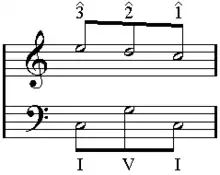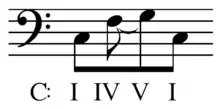Bass arpeggiation
In Schenkerian analysis, the bass arpeggiation (German: Bassbrechung) is the bass pattern forming the deep background of tonal musical works. It consists in scale steps (de: Stufen) I-V-I, each of which may span hundreds of measures of music in the foreground.[2]


The bass pattern is an arpeggiation in the sense that its middle note (V) first arises as the fifth of the elaborated chord (I), of which it is the upper-fifth divider.[3] It is only when it meets with the passing note ![]() of the fundamental line that V becomes an independent chord within the first one.[4] See also Schenkerian analysis, The arpeggiation of the bass and the divider at the fifth.
of the fundamental line that V becomes an independent chord within the first one.[4] See also Schenkerian analysis, The arpeggiation of the bass and the divider at the fifth.
The bass arpeggiation properly speaking consists in the three scale steps I-V-I exclusively, but it may be elaborated at a remote level: see Schenkerian analysis, Elaboration of the bass arpeggiation.
Sources
- Pankhurst (2008), p.51.
- Pankhurst, Tom (2008). SchenkerGUIDE, p.52. ISBN 9780415973977
- Schenker, Heinrich (1979). Free Composition, § 1.
- Schenker (1979), § 23.
